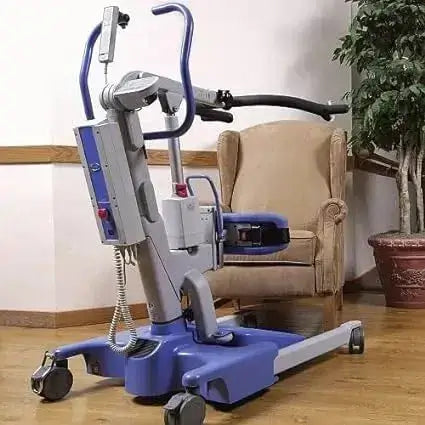Lifting and Transporting a Patient from Bed to Chair
Introduction
Lifting and transporting a patient from bed to chair, or vice versa, is a fundamental yet crucial aspect of caregiving and healthcare. Whether you're a family member shouldering the responsibility or a healthcare professional managing daily routines, mastering the art of this transfer is critical. The safety and well-being of both the patient and the caregiver hinge on the proper execution of this task. In the following paragraphs, we will delve into the essential techniques and safety guidelines necessary for lifting a patient from bed to chair, ensuring a seamless and secure process that prioritizes the comfort and health of those involved.

Table of Contents
Understanding The Basics
Transferring a patient from bed to chair is a nuanced process that begins with a fundamental understanding of the basics. Before attempting any lift, it is crucial to:
- Conduct a thorough assessment of the patient's mobility and overall health. This initial step allows caregivers and healthcare professionals to tailor their approach based on the individual needs and limitations of the patient.
- Effective communication is paramount during this assessment phase. Engage in a dialogue with the patient to understand their comfort level, any pain or discomfort they may be experiencing, and their ability to participate in the transfer. Clear communication not only fosters trust but also ensures that the patient is an active participant in their own care, promoting a sense of empowerment.
- Recognize and address common challenges associated with patient transfers. This includes factors such as the patient's weight, any existing medical conditions, and the potential for sudden movements or instability. By acknowledging these challenges upfront, caregivers can develop a strategy that mitigates risks and promotes a safer transfer process.

In the subsequent sections of this blog, we will delve deeper into the techniques, safety precautions, and adaptive strategies that form the foundation of successful patient transfers. By mastering the basics, caregivers and healthcare professionals can establish a solid framework for lifting a patient from bed to chair, prioritizing both the physical well-being and dignity of those under their care.
Essential Techniques for Safe Lifting
Mastering the art of safe lifting is pivotal for caregivers and healthcare professionals alike. The key to success lies in adopting proper body mechanics.
- Begin by ensuring a stable base – Feet Shoulder-Width Apart – and bending at the knees rather than the waist when reaching for the patient.
- This technique minimizes strain on the back and maximizes the use of powerful leg muscles.
- As you lift, maintain a straight spine and avoid twisting the torso to prevent unnecessary stress on the spine.

Incorporate the use of assistive devices, such as transfer belts or sliding boards, to facilitate smoother transfers. A transfer belt can provide additional support around the patient's waist, allowing the caregiver to maintain a secure grip during the lift. Sliding boards, on the other hand, reduce friction and make it easier to move the patient from the bed to the chair. Tailoring these techniques to the specific needs of the patient ensures a personalized and safe approach, emphasizing the importance of adaptability in the caregiving process.
Safe Precaution for Caregivers
There will be some overlap in this section from the previous section covering techniques, but it’s critical to ensure you’re transferring the patients correctly to make sure you don’t injure yourself in the process. The well-being of caregivers is paramount in the patient transfer process, and implementing safety precautions is essential to prevent injuries.
- One crucial aspect is maintaining proper body mechanics throughout the entire lifting procedure. Encourage caregivers to lift with their legs, keeping the load close to their body, and avoiding sudden or jerky movements.
- Regularly practicing and promoting these techniques not only ensures the safety of the patient but also safeguards the caregiver's physical health in the long run.
- Recognizing the signs of strain or fatigue is equally important. Caregivers should be attuned to their own bodies and be proactive in taking breaks when needed.
- Introducing simple stretching exercises into their routine can contribute to building strength and flexibility, reducing the risk of musculoskeletal issues.
By prioritizing caregiver safety through these precautions, we can create a sustainable and supportive environment for those dedicated to the well-being of others.

Customizing The Process for Different Patients
Recognizing the diversity in patient needs is crucial for caregivers and healthcare professionals. Each patient brings a unique set of challenges and requirements to the transfer process, and adapting techniques accordingly is paramount.
- For patients with limited strength or mobility, consider implementing additional support mechanisms such as overhead trapeze bars or bed rails to facilitate a more controlled transfer.
- Understanding the specific medical conditions of the patient is equally vital; for instance, individuals with arthritis may benefit from slower, more deliberate movements.
Tailoring the transfer process to the individual extends beyond physical considerations. Take into account the emotional and psychological aspects of the patient, ensuring open communication and addressing any anxieties or concerns they may have. By customizing the transfer process based on the diverse needs of patients, caregivers can provide compassionate and effective care, fostering an environment that promotes both physical well-being and emotional comfort.
Incorporating Assistive Technology
As technology continues to advance, caregivers and healthcare professionals have access to a range of assistive devices that can significantly enhance the patient transfer process. Mechanical lifts and hoists, for example, offer a high level of support, minimizing the physical strain on caregivers and providing a secure means of transferring patients. These devices are particularly beneficial when dealing with patients with limited mobility or those who require specialized care.
Top 5 Assistive Technologies for Patient Transfers:
- Hoyer Lifts: A versatile and widely-used device, Hoyer lifts are designed to assist with transfers, allowing patients to be lifted and moved with minimal effort.
- Transfer Belts: Offering additional support around the patient's waist, transfer belts are simple yet effective tools that aid in maintaining a secure grip during lifts.
- Ceiling Lift Systems: Installed on tracks on the ceiling, these systems provide a smooth and controlled transfer, eliminating the need for manual lifting and reducing the risk of strain.
- Sliding Boards: These thin, smooth boards reduce friction, making it easier to slide the patient from the bed to the wheelchair, promoting a gentler transfer process.
- Electric Patient Lifts: Powered by electricity, these lifts provide a convenient and efficient solution for transferring patients, often equipped with features such as adjustable height and easy maneuverability.
Selecting the right assistive technology involves a careful consideration of the patient's needs and the caregiver's comfort level with the equipment. Training on the proper use of these devices is essential to ensure both efficiency and safety. By embracing assistive technology, caregivers can not only streamline the transfer process but also contribute to the overall well-being of both the patient and the caregiver, marking a significant stride in modern healthcare practices.
Conclusion
The process of lifting a patient from bed to chair is not merely a physical task; it embodies the essence of compassionate caregiving. Whether one assumes the role of a devoted family member or a healthcare professional managing daily routines, mastering the techniques outlined in this blog is imperative. Through an exploration of fundamental principles, essential techniques, and the integration of advanced assistive technologies, we've unveiled a holistic approach that centers on the well-being and dignity of both the patient and the caregiver. As you navigate this crucial responsibility, let this guide be your aid, equipping you with the knowledge and skills necessary for a seamless and secure transfer process. Embrace these principles, and may your caregiving journey be characterized by safety, respect, and the utmost commitment to the health of those entrusted to your care.
Let Us Know What You Think!
Your thoughts and questions are incredibly valuable to us, and we'd love to hear from you. If you have additional insights to share, your comments can spark meaningful discussions and enhance the collective knowledge of our community. Don't hesitate to ask any questions you may have; our team is here to provide answers and engage with you. So, please, take a moment to leave a comment or question below. Your input is much appreciated!



















Leave a comment